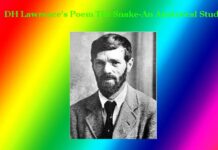Henry Reed | Naming of Parts | An Analytical Study
Henry Reed | Naming of Parts | An Analytical Study
Henry Reed | Naming of Parts | An Analytical Study
The poem ‘Naming of Parts’ by Henry Reed is a section of a sequence of poems titled ‘Lessons of War’. Like Wilfred Owens’ ‘Dulce et Decorum Est’, this is also a poem of War. There are five stanzas and two distinct speakers in the poem: one the strict instructor and the other a new sensitive recruit (soldier). The instructor teaches the new recruit to operate a rifle, but at the same time is being distracted by the outer beauty of springtime. They have gone side by side presenting their views on war and normal life. Thus the poem deals with two contradictory themes: the theme of the destructive power of war and the theme of the beauty of life. The style of the poem is humorous with a lot of puns.
The poem is divided into some stanzas. Each stanza bears two distinct parts. The first three lines of each stanza (except the final stanza) present the instructor’s voice and the second part contrasts the world of the military camp with the world of nature.
In Stanza-I, the instructor teaches the name of the parts of the gun with mostly technical terms; but when the recruit’s voice takes over words flow into long musical sentences evoking sensuous images of colour, beauty and elegance. The instructor says:
‘Today we have naming of parts. Yesterday.
We had daily cleaning. And tomorrow morning,
We shall have what to do after firing.’
On the other hand, the recruit is distracted by the beauty of nature as:
“Japonica
Glistens like coral in all of the neighbouring gardens.”
The irony here is that the soldiers are shown to be lacking in all that the garden represents. The garden is a symbol of life and beauty.
In stanza -II, the instructor shows two parts of the gun as upper and lower sling swivels and says that they would know their function when they are given a sling to use. Then the soldiers look at the bees in the garden and notice that the bees are also highly structured and regimented but the comparison here is ironic because the bees are intimately related to the flowers and are an integral part of the natural order of things whereas the soldiers are related to the activities which represent chaos and destruction.
In stanza III, the instructor continues naming the parts of a gun such as a thumb and fingers in the same mechanical fashion. On the other hand, the recruits respond to the sensuality of the spring activity in the garden. This emotional response to the ‘fumbling bees assaulting the flowers’ makes the recruit all the more conscious of that which they don’t have as soldiers.
When the soldiers notice that the ‘bees are assaulting and fumbling the flowers’ the image of sexuality appears in the poem. It is developed through the pun on ‘easing the spring’ which is at once a part of the gun and also sexual reproductive activity. The bolt and cocking piece of the gun and the breech that goes backward and forwards – all actions with reference to the gun – have sexual implications and refer to the sexual activity running on the objects of nature. In the case of the gun, all the actions shown and instructed by the instructor lead to death and destruction, whereas the actions in the garden lead to the fertility and regeneration of life.
In the first four stanzas the two voices: the voices of the instructor and the voices of the soldier are distinctly different yet metaphorically connected. The recruit takes one or the other instruction and relocates that in the context of the garden. This relocation which is only partial in the earlier stanza is made perfect in the final stanza with the line, ‘They call it easing the spring’. The alternating voices fuse into the single voice of the new soldier.
In the poem, Henry Reed projects two speakers with the main poetic device of imagery and wordplay to produce two connotative meanings. The world of war and the world of beauty is put side by side with the imagery of the Japonica plant that shines like a coral and the imagery of a rifle in the first stanza. The imagery of missing ‘piling swivel’ is contrasted with the imagery of tree branches that hold the trees in an eloquent manner. The activities of the bees and the flower plants as ‘easing the spring’, ‘assaulting and fumbling the flowers’, ‘rapidly forward and backward’ etc. figuratively suggest sexual connotations. 0 0 0
Henry Reed | Naming of Parts | An Analytical Study
Read More: E De Sauza’s Poem ‘Marriages are Made’: An Analytical Study
N. B. This article entitled ‘Henry Reed | Naming of Parts | An Analytical Study’ originally belongs to the book ‘World Poetry Criticism‘ by Menonim Menonimus. Henry Reed | Naming of Parts | An Analytical Study
Books of Literary Criticism by M. Menonimus:
- World Short Story Criticism
- World Poetry Criticism
- World Drama Criticism
- World Novel Criticism
- World Essay Criticism
- Indian English Poetry Criticism
- Indian English Poets and Poetry Chief Features
- Emily Dickinson’s Poetry-A Thematic Study
- Walt Whitman’s Poetry-A Thematic Study
- Critical Essays on English Poetry
- Tawfiq al-Hakim’s Novel: Return of the Spirit-An Analytical Study
- Tawfiq al-Hakim’s Novel: ‘Yawmiyyat Naib Fil Arayaf’-An Analytical Study
- Analytical Studies of Some Arabic Short Stories
- A Brief History of Arabic Literature: Pre-Islamic Period …
Related Searches:
- Naming of Parts Poem Summary and Analysis
- Naming of Parts‘
- ‘Dulce et Decorum Est’ Summary and Analysis
- Analysis of the Poem ‘Dulce et Decorum Est’
- ‘Harlem’ by Langston Hughes
- Still I Rise’ by Maya Angelou
- Telephone Conversation by Wole Soyinka Poem Analysis
- Marriages are Made by E De Sauza Summary











